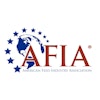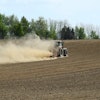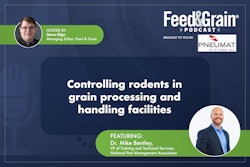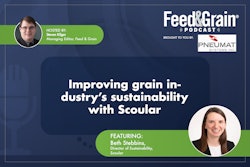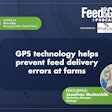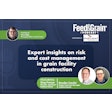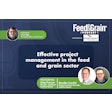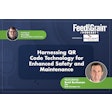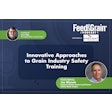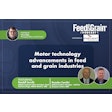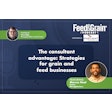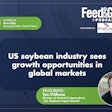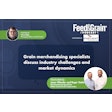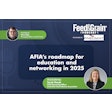
This episode of the Feed & Grain Podcast features Jeff Schreiner, president and CEO of Roger, discussing how their digital ecosystem is transforming grain logistics. Host Steven Kilger explores how Roger's technology converts paper-based processes into a streamlined digital workflow, connecting shippers and carriers while automating compliance requirements and significantly reducing payment times. Schreiner explains their "OnRamp" product, which simplifies relationship management between parties by digitizing contracts, insurance verification and facility requirements.
Transcript
Steven Kilger - 00:00
Hello, my name is Steven Kilger. I'm the Managing Editor of Feed & Grain Magazine and the host of the Feed & Grain Podcast. Thank you so much for joining me today as we dive deep into the issues affecting feed manufacturing, grain handling and allied industries.
Today's episode is brought to you by the Binwhip from Pneumat Systems. The powerful dual-impact Binwhip removes the toughest buildup and blockages in industrial storage silos, without hazardous silo entry. Learn more today at binwhip.com.
Kilger - 00:31
I am sitting down with Jeff Schreiner. He's Roger's Chief Executive Officer. We talk about the advantages of digitizing your shipment, paperwork, and workflow, along with other aspects of your facility to make both your life easier and to be less reliant on having people in the office and staff to take care of that kind of thing. All the while making your entire facility run more efficiently. So, thank you so much to Jeff for stopping by and jumping right into it.
Hi, everyone. Thanks for listening to the Feed & Grain Podcast. My name is Steven Kilger. I'm sitting here with Jeff from Roger today. Jeff, why don't you tell the industry a little bit about yourself?
Jeff Schreiner - 01:11
Hi, Steven. Hi, everyone. My name is Jeff Schreiner. I'm the president and CEO of Roger. Roger is a digital-free ecosystem. Jeff, a little bit of background about me. I grew up on a farm 60 miles straight south of Omaha, Nebraska, in a little town called Douglas, Nebraska.
So, our whole family grew up on the farm and we had a farming operation, and we had a bit of a trucking business, which is ironic. Now I'm back into technology and trucking all these years later.
Kilger - 01:38
That is fascinating how that tends to work, isn't it? It's all circular in the end. But always nice to have Corn Husker on the podcast. Can you tell me a little bit about Roger himself?
Schreiner - 01:54
So, Roger is really the transformation of what is now paper and email and text around the logistics of moving bulk products in trucks to a digital format.
So, we are, as our name says, we're the electronic version of converting all things that were once paper and inefficient, at times to digital, which is all real-time, all up in the cloud, and a great way to do business and a modern way to get better and more effective at doing business.
Kilger - 02:27
It's really fascinating the things that you guys have come up with so far. Can you tell me about the Roger system? Yeah, sure.
Schreiner - 02:34
Roger is kind of end-to-end. Think about it in terms of a digital ecosystem. So, we're solving problems for both shippers in the grain and other bulk product industries and carriers. So, our goal is to make everything from the introduction of those two groups very seamless and very easy to qualify those relationships to get them to a point where they can do business together faster.
So, we introduce them, and we do all the compliance requirements and make sure that everybody's up to snuff and we have them there. We have everyone's insurance and they're all taken care of so that you can do business. And then we get to a point where we're tying together the things that are moving in the back of a truck like all the commodities that are coming out of an elevator to where it needs to go. And so, it's the commodity that is intricately linked to the logistics move.
So we do the connection of what commodities are going to move, when they need to move it, how they want to get it done, and when's it going to show up. Exactly. And then ultimately, the whole point would be when all these things happen and they work well, of course, there are payments at the back end of that process.
And so, our goal was to make that completely effective through automation. And so, what used to be somewhere between 17 and 35 days to get paid for some of these things for a carrier. We're down in many cases to below three days. We have some that are actually same-day payments because all of things tie up with contracting stuff.
It's an exceptionally better condition than it was when 50 years ago we were carrying around clipboards and sending things through the mail and waiting for things to happen and if there were any questions, you didn't know it and you had to a lot of phone calls and things involved in that whole process. So it's kind of changing the whole dynamic of how that environment works.
Kilger - 04:26
I once had a conversation with an automated scaling company, and they said that something that really interests me is we're doing all this splitting and managing all these contracts and things. It seems like it's crazy in this day and age, especially since so many still write physical checks and send them out and things like that. So, Roger is on the cloud. It's also an app. It's quite a few things, right?
Schreiner - 04:47
For shippers and carriers, there's the cloud version. So, if you're sitting in an elevator, you get a web GUI and you get a web where you can see where all your trucks are coming inbound and going out and out. You can see all the paperwork coming in at you. So, there's that component where if you're at a site, A shipper can see everything that's happening in front of them and really understand how to manage their facilities much better.
If you're a carrier, you're seeing the same view where your carriers know where all the trucks are, where they're going to go if they're going to be on time, if they're going to be late, and then there's an app that goes along with all of this. So, carriers can be mobile, shippers can be mobile, a driver is another role underneath a carrier, and the drivers have their own apps. They get routed in the best way possible from where they need to start, even if it's a very defined place in an armored field somewhere.
Schreiner - 05:37
Think about it, hey, I need to go in the southwest gate and meet you at the X corner, they can get that really prescriptive, fine place to go and it will most efficiently direct them all the way to where they need to go and give them expectations all along the way. The driver doesn't have to take a phone call, where are you at, and get that phone call going back and forth.
The app actually tells everyone downstream what's happening, and when it's going to happen, and it sets some expectations about when things are going to get delivered.
And so all of that really takes the burden of a lot of administrative stuff out of some of the way things work today and it lets the system take those things so our drivers can focus on drivers and our shippers can focus on selling and making that product go where it needs to go.
Kilger - 06:22
We've driven to farms, they're confusing backcountry roads that if you're not intimately familiar with it, it's in the way of the past, right? Where a farmer, he can't, he's got such a large farm, he's producing so much grain, he can't drive it there himself, right?
And elevators no longer have giant fleets that are doing it, so It seems like this is a great way to connect those drivers to an industry that quite frankly has better things to do, right? Like other stuff, they need to get done. So can you tell me a little bit, say I'm Feed & Grain elevator and I'm on board? I'm ready to do this. What are my first steps? What's my experience like when I reach out to Roger and tell them I want to get involved?
Schreiner - 07:05
You know, it's a really pretty straightforward process. It's not any simpler. There's no software to install. It's all online. You get an idea. If you want to give it a run, start converting your facility and or all your carriers to do business this way, it can be up and running in a day or you just do that. Now, a lot of the elevators have already made investments in technologies. Sometimes they have already invested in planning systems, or they operate with their commodity trade risk management systems.
And if you want to get really sophisticated, we can integrate with all of those things. So, there's no dual entry. So, you just put it in your normal, the way you do business and it just kind of flows downstream and Roger does its thing and gets your truck moving on time and then it flows upstream and says, hey, your paperwork's in and let's get it integrated with your systems that pay people.
So, there's that experience on the shipper side, on the carrier side, basically the same start, they download their apps and they get an account and start using parts and pieces of the ecosystem which we give them nice videos and things to understand it. It's pretty easy to jump into and understand how to get around. It's kind of like a modern-day app.
We want you to be able to get in and start using it almost immediately. That's the whole point of it.
Kilger - 08:23
I remember last year, I remember thinking of it as a kind of rideshare of this kind of because you don't need to have a direct contract as a shipper or an elevator right with each other. You just have to be involved with Roger. Is that correct?
Schreiner - 08:40
I would tell you there is still the obligation. So shippers have their general terms that they want and they do need to have that applied to the way the carrier operates. So there is some direct interaction. We don't perform as a broker between the two and we don't take a position with that.
We just basically help them facilitate the whole movement all digitally. And that's the best thing is it doesn't massively redesign your processes. It just allows you to go from paper and phone calls and texts and all that stuff to electronic and then let the system do things too that learn and coach you how to do that job even better than maybe you were doing it when it was all manual.
Kilger - 09:20
And it must make making those integrations between shippers and elevators or processors a lot easier, right? You no longer have to tell them all the stuff exactly where you can deliver and where you can do all this. That's all kind of handled by the app, right? So that's got to be a huge time saver.
Schreiner - 09:38
One thing it does was it may expose you to new opportunities you may not have known existed. If there was a carrier that falls in your space and they all rock or something else and you didn't really have an introduction to that person, well now you might have an opportunity to do business with that carrier Secondarily, maybe a carrier has the same problem which is for a long, long time they just have a certain set of businesses and calls they do and they just never knew that they could fill out their dance card in a different way which is really the advantage of things moving down the digital path. I think this also has to apply to the constraints around finding people to do jobs.
This is an extension to get to more audiences of people and if you think about it over the course of time, this is the way a lot of people run lots of parts of their lives online banking, shopping, you name it they kind of have learned that this is an effective way to get things done. This is just an extension into this industry the way that all those other industries kind of took off and started transforming. We're in that space now and it's happening very fast as you can imagine.
Kilger - 10:42
I mean let's face it rural America has a labor shortage; agriculture has a labor shortage and any time you can work. Automation is going to save the grain industry, you know, because let's face it, there's not going to be a huge boom in rural towns at least no time in the near future. So this is how we kind of adapt and keep those grain elevators working is adopting technology, which seems like you guys have a great, great product for that kind of thing.
Schreiner - 11:10
We love the story where a grain elevator that's been in town for many years you know jumps in and now they're the most sophisticated technology-looking business out there.
We love those stories because it shows that our rural American businesses have every ability to compete like they never have in the past and maybe a few years ago you would have had a conversation about well the infrastructure or the internet doesn't support it or any of that stuff. We're finding that that's a very rare situation almost everywhere in every part of the country has the ability to do this kind of work now.
I think it extends the range, the radius of doing business. Which is a great story.
There could be, I say, case studies on how this all occurred where rural America has seen a blossoming of new work and new opportunities just because people can work wherever they want to work these days.
Kilger - 12:07
I mean, we all have phones now, right? We all at least have, I mean, there's parts of the country, but most of us, at least in town and stuff, have some kind of cell phone signal, some kind of thing, and that's what you really need to work with Roger, right?
Schreiner - 12:20
That's a fundamental breakthrough that we're leveraging.
Kilger - 12:23
What should people do if they are interested in kind of finding out more about Roger? You're on the Feed & Grain Buyer's Guide. Your website's going to be listed in the show notes. Anything else? Any videos you suggest watching on your site? Anything like that?
Schreiner - 12:36
We have a whole host of videos. The first thing you can do is visit that site, there's a really short if you want to run it through its bases and see what it does and how it works. In a short time, you can watch a video and just basically understand how the environment works and what it takes to get there and it's not much to get up and running pretty quickly.
And then Secondarily, I think there's a pathway that kind of helps us decide what the best go-forward plan is. Ecosystems have, like ours, lots of parts and pieces to them.
Everything from, as we talked about, that introductory, which is let's just get you introduced and get your compliance program handled, to how do we plug into existing systems, if you want to just try it without going through the integration that's a very easy thing to do and we give you a pretty nice way to just give it a give it a trial run and see how it looks and see how you can make it part of your business.
That's why I think your feed and grain audience would find it very easy to jump into that model and just get to a point where they start to understand what it is. In under 15 minutes people would mostly understand okay this is how we work and what it can do. The power of that also, as you get into it, you get to leverage more and more. You'll understand more about how you understand how to work that data. Where does that data come from? How do you work it out? The early adopter says, here's how I jump in.
The later adopter says, well, I can really fine-tune my business because I know where the data is. I know where I do well. I know where my best transactions are and what they look like now because I've studied them.
Kilger - 14:15
What also fascinates me about this kind of technology, it gets better the more people are involved in it, right? Because the bigger your local network is, the more opportunities you have. So that's also kind of a cool thing as people learn about it gets even better.
Schreiner - 14:31
Two sides to that equation it's great it's a great question two sides one is you have to be very confident that data is yours and yours alone and that you're secure and protected and I'm private we don't do that we don't sell we don't do advertising with that data so that's one side if you're thinking about it side number two is it learns over the course of time You, the company and the system teaches you how to do that job in the most effective way.
You can see on a dashboard what your business driver metrics are. You can say what situations have really worked well for me. We call that RogerIQ and RogerIQ does everything from just being able to view your business in one pane of glass to, hey, point out where you may be on the train to do better as a business or where you may need to refine things and that's the benefit and the more people use the product, the smarter it gets. So the smarter it starts to say oh I know generally speaking what a good situation looks like and I can start to coach you on that.
Kilger - 15:37
That's another huge thing about how the industry is going to continue and be profitable is that low-hanging fruit is data analytics and if Roger can help with that because let's face we need all the help we can get it's a big technological issue that not every elevator is going to be able to do so if Roger assists in that that's fantastic.
I would be remiss if I didn't ask about your newer product, the Roger onramp.
Can you tell me a little bit about that?
Schreiner - 16:01
onramp is a product geared for the streamlining of relationship requirements. So when you set up a relationship between shipper and carrier, there are basic premises that have to happen. One, there's usually a hauling contract in that mix. So every shipper that you do business with, you want to sign that hauling contract so they can do the business. Of course, we have it all electronic so they can do it in seconds. It's all online, with no printers, no paper, it's just you can click that thing and go. Two, you may have other requirements like I have specific things that I want to have happen in my facility like I want to see a certain training characteristic or a safety qualification and it does that.
Three, it looks at what I have as a shipper maybe some certain requirements for insurance that I require of my carriers. And it goes through and checks. It actually works with the system and our people ensure that it works with the carrier's insurance agent and so their certificates of insurance, we read them, we compare them, we contrast them with what the what shippers requirements are and we say, hey, this one looks great. It's good to go. Where in the past, I think people had to manually do those. They manually did those things. And then lastly, the benefit of this is let's say that carrier already did this for somebody else down the road.
And they want to offer you too, well a portion of that might already be completed.
Carriers do that in a fraction of the time compared to what they used to do which is compile all this paperwork and have to submit it over and over and over every time they wanted to do it. The shipper gets that qualified in a fraction of the time that they used to. And then they're off and running and they have their loads for the week all filled out because they are not dealing with paperwork on the new carrier they wanted to bring on.
So, onramp is specifically designed to take all of that administrative stuff out of the manual processes that it's in today between shipper and carrier and just let the system do all of that and keep you up to date throughout the course of the year.
Kilger - 18:09
I can see why that comparison at Uber isn't fair at all because you guys do quite a bit of the background and comparison and legwork of what they need for that. Just being able to connect it to the insurance part alone is just a huge time saver and convenience for everybody.
Schreiner - 18:26
It's not something that I think most people want to do all that often. They don't want to have to deal with all of that stuff. Carriers, I'm sure, don't want to be asked for their insurance certificates over and over and over or their driver's license or their w9s. They get asked that all the time and almost every carrier does business with more than one shipper so they're having to duplicate that over and over. We take all of that out of there, out of the equation. The carriers and the shippers basically approached us and said, can you do this for us? Because we really struggle at times to keep on top of it.
And our business moves so fast that we believe that we might be opening up some risks if we don't get somebody to help us methodically get through this and maybe help us. By systematic means, just get it done. I think that's what Onramp is all about.
Kilger - 19:14
Keeping the data to you there and updating it throughout the year. I mean, We all pray that a big thing doesn't happen or an accident doesn't happen, but what's even worse than that is having an accident happen and then realizing you don't have any documents to back it up and you don't know where anything is.
Schreiner - 19:31
If that happened, the immediate thing is your insurance agents have to get involved, they have to insure. You've got insurance agents both on the ship and carrier's side, they have to get involved.
If it's all taken care of and it's in a program, that you've started way down the right path where and in comparison today that we're not there as an industry we've got to get to that and I wouldn't I would believe at some point in time their insurance folks are going to start to maybe push towards I want to see this more actively managed I want to see it I think we're kind of helping our shippers and carriers get ahead of that curve so that it never becomes the insurance agent demanding it we're just going to say we already have a good program for the industry And we're a little bit in a new space in this area.
We're taking all of the feedback that we're getting when it's rolling with these shippers and carriers and just building a right of the product in real-time.
Kilger - 20:23
It is amazing. And if you're a grain elevator manager, I mean, you got in, you're probably in that position because you love grain science. You're good at that part of the job. And then so many people get thrown into this other part, which is also you have to manage a bunch of paperwork, which always seems very unfair to me. So it's great that technology stepping up helped with that. It's great for the industry. Industry overall.
So thank you for what you're doing and hopefully more people check out what you're doing because it's like I said it seems like it gets stronger the more people are involved. I appreciate that.
Schreiner - 20:51
We again are super appreciative of the folks that help us to drive how to make it better and that feedback is the best part of the job is to hear directly from the source and say how we constantly get this better and make it more effective so you can do what you want to do rather than the things you don't.
Kilger - 21:11
Exactly. Well, thank you so much for talking with us today, Jeff. Hopefully, you can come back soon and we can talk about more of this type of, I guess, what do you call it? Phone, portable, digital technology, whatever it's called. Hopefully, you can talk more about it with us soon. Thank you again so much for being a guest. Have a great day and thanks for listening. Bye.
.jpg?auto=format%2Ccompress&crop=faces&fit=crop&h=48&q=70&w=48)
